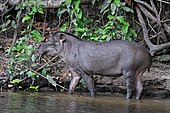List of the Cenozoic life of Oregon
This list of the Cenozoic life of Oregon contains the various prehistoric life-forms whose fossilized remains have been reported from within the US state of Oregon and are between 66 million and 10,000 years of age.
A[]
- Abies
- †
- †
- †AcamptogenotiaShell of an Acamptogenotia sea snail
- †
- †
- Acanthocardia
- †
- Acer
- †
- †
- †
- †
- †
- †
- †
- †
- †Acericecis
- † – type locality for species
- †Achaenodon
- † – type locality for species
- †
- †
- Acila
- †
- †
- †
- †
- †
- †
- Acmaea
- †
- †Acritohippus
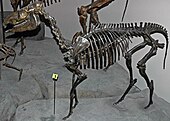 Mounted fossilized skeleton of the Miocene horse Acritohippus
Mounted fossilized skeleton of the Miocene horse Acritohippus- †Acritohippus isonesus
- Acteon
- †
- †
- †Actinidia
- †Actinidia oregonensis
- †
- †
- †
- †
- Admete
- †
- Aechmophorus
- †Aechmophorus occidentalis
- †Aesculus
- †Aetiocetus – type locality for genus
 Life restoration of the Oligocene baleen whale Aetiocetus
Life restoration of the Oligocene baleen whale Aetiocetus- †Aetiocetus cotylalveus – type locality for species
- † – type locality for species
- Aforia
- †
- † – or unidentified comparable form
- †
- †
- Agelaius – tentative report
- †Agriochoerus
 Life restoration of the Eocene-Oligocene even-toed ungulate Agriochoerus
Life restoration of the Eocene-Oligocene even-toed ungulate Agriochoerus- †
- Aix
- †Aix sponsa
- Alangium
- †
- †
- †
- †
- †
- †
- †
- †
- †
- Alnus
- †
- †Alnus heterodonta
- †
- †
- †
-
- † – or unidentified related form
- †Amebelodon
 Life restoration of the Miocene elephant relative Amebelodon. Margret Flinsch (1932).
Life restoration of the Miocene elephant relative Amebelodon. Margret Flinsch (1932). - Amelanchier
- †
- †
- †
- † – type locality for species
- Ammospermophilus
- †
- Ampelocissus
- †
- †
- †
- †Amphicyon
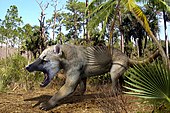 Life restoration of the Miocene-Pliocene beardog Amphicyon
Life restoration of the Miocene-Pliocene beardog Amphicyon- †Amphicyon frendens
- †Amphicyon galushai – or unidentified comparable form
- Amphissa
- †
- †Ampullina
- †
- †Anabernicula
- Anadara
- †
- †Anamirta
- †
- Anas
- †Anas acuta
- †Anas americana
- †Anas boschas
- †Anas carolinensis
- †Anas clypeata
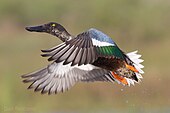 A living Spatula clypeata, or northern shoveler
A living Spatula clypeata, or northern shoveler - †Anas cyanoptera
- †Anas discors
- †Anas platyrhynchos
- Ancilla
- † – type locality for species
- †
- †
- †
- †
- †
- Anona
- †
- †
- †
- †
- †
- †
- †
- †
- †
- Anser
- †Anser albifrons
- †Anser condoni – type locality for species
- †
- †
- Antillophos
- †
- Antilocapra
- †Antilocapra americana – or unidentified comparable form
- †
- †
- Aphananthe
- †
- †Aphelops
- †
- Aquila
- †Aquila chrysaetos
- † – type locality for species
- † – type locality for species
- Arbacia
- † – type locality for species
- †Archaeocyon
- †
- †Archaeohippus
- †
- †
- † – or unidentified comparable form
- †Archaeotherium
- Architectonica
- †
- Archoplites[1]
- † – type locality for species[1]
- †Arctodus
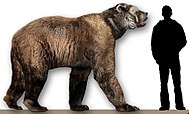 Restoration of an Arctodus, or short-faced bear, with a human to scale
Restoration of an Arctodus, or short-faced bear, with a human to scale - †
- †
- Ardea
- †Ardea herodias
- † – type locality for species
- Argobuccinum
- †
- †
- †
- †
- †Ascosphaera
- †
- †
- †
- †
- Astraea
- †
- Astreopora
- † – type locality for species
- Astropecten
- †
- †
- †Aturia
 Fossilized shell of the Paleocene-Miocene nautiloid cephalopod Aturia
Fossilized shell of the Paleocene-Miocene nautiloid cephalopod Aturia- †
- † – or unidentified comparable form
- †Aucuba
- †
- †
- †
- Aythya
- †Aythya marila
B[]
- Balaena
- Balaenoptera
- †Balaenoptera acutorostrata – or unidentified comparable form
 Illustration of a living Balaenoptera acutorostrata, or common minke whale
Illustration of a living Balaenoptera acutorostrata, or common minke whale
- Balanophyllia
- Balanus
- †
- Bartramia
- † – type locality for species
- †Basirepomys
- † – or unidentified comparable form
- † – type locality for species
- Bathybembix
 Shell of a Bathybembix sea snail
Shell of a Bathybembix sea snail- †
- † – type locality for species
- Bathytoma
- †
- †
- †
- Bela
- †
- Betula
- †
- Bittium
- †
- †Bonellitia
- †
- † – type locality for species
- † – type locality for species
- †
- †
- Boreotrophon
- †
- †Boreotrophon stuarti
- †Borophagus
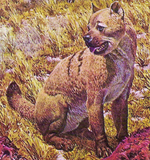 Restoration of two of the Miocene-Pliocene bone-crushing dog genus Borophagus preying on a camel. Jay Matternes (1964).
Restoration of two of the Miocene-Pliocene bone-crushing dog genus Borophagus preying on a camel. Jay Matternes (1964).- †Borophagus pugnator
- †Borophagus secundus – or unidentified comparable form
- Botaurus
- †Botaurus lentiginosus
- †
- † – or unidentified comparable form
- †
- Brachidontes
- †
- Branta
- †Branta bernicla
- †Branta canadensis
- † – tentative report
- †
- † – type locality for species
- †
- †
- †
- †
- †
- Bubo
- †Bubo virginianus
 A living Bubo virginianus, or great horned owl
A living Bubo virginianus, or great horned owl
- Buccinum
- †Buccinum strigillatum
- Bullia
- †
- †Bumelia – tentative report
- †
- †
- †
C[]
- Cadulus
- Calliostoma
- †
- †
- Callista
- †
- Callorhinus – tentative report
 A living Callorhinus ursinus, or northern fur seal
A living Callorhinus ursinus, or northern fur seal - ] †Calocedrus
- †
- †Calycocarpum
- †
- Calyptraea
- †
- †
- †
- †
- †Camelops
- †Camelops hesternus
- Cancellaria
- †
- †
- Canis
- †Canis dirus – or unidentified comparable form
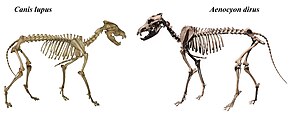 Modern mounted skeleton of Canis lupus, the grey wolf, to scale with a fossilized skeleton of the Pleistocene wolf Canis dirus, or dire wolf
Modern mounted skeleton of Canis lupus, the grey wolf, to scale with a fossilized skeleton of the Pleistocene wolf Canis dirus, or dire wolf - †Canis edwardii
- †Canis latrans
- †Canis lupus – or unidentified comparable form
-
- † – type locality for species
- †
- †Carpocyon
- †
- †
- Carya
 A living Carya, or hickory tree
A living Carya, or hickory tree - Caryophyllia
- † – type locality for species
- Castanea
- †
- Castanopsis
- †
- †
- Castor
- †Catalpa
- Cedrela
- †
- †
- †
- Celleporina
- Celtis
- †
- †Centrocercus
- †Centrocercus urophasianus
- Cercidiphyllum
- †
- Cercis
 Flowers of a living Cercis or redbud tree
Flowers of a living Cercis or redbud tree- †
- Cerithiopsis
- † – or unidentified comparable form
- †
- †
- †Charitonetta
- †Charitonetta albeola
- Chen
- †
- †Chen rossii
- †Chendytes
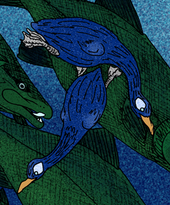 Life restoration of the Pleistocene-Holocene Chendytes, or Law's diving-goose
Life restoration of the Pleistocene-Holocene Chendytes, or Law's diving-goose - Chione
- †
- †
- Chlidonias
- †Chlidonias nigra
- Chlorostoma
- †
- †Choerodon
- †
- †Chrysodomus
- †
- †
- †
- †
- †
-
- †
- †
- †
- Circus
- †
- Cladrastis
- †
- Clangula
- †Clangula hyemalis
 A living Clangula hyemalis, or long-tailed duck
A living Clangula hyemalis, or long-tailed duck
- Cleyera
- †
- Clinocardium
- †
- † – or unidentified comparable form
- Cochliolepis – tentative report
- †
- Colaptes
- †
- †Colodon
- Columbella
- †
- Colus – tentative report
 Shells in differing orientations of Colus whelk sea snails
Shells in differing orientations of Colus whelk sea snails- †
- Colymbus
- †
- †
- † – type locality for species
- †
- †
- †
- Comitas
- †
- †Comitas oregonensis
- †Comitas spencerensis
- †
- †
- Comptonia
- †
- †
- †
- †
- Conomitra
- † – type locality for species
- Conus

- † – type locality for species
- † – type locality for species
- †
- †
- †
- †
- †Cophocetus – type locality for genus
- † – type locality for species
- Corbula
- †
- †Cormocyon
- †
- Cornus
- †Cornus clarnensis
- †Cornwallius
- †
- Corvus
- † – type locality for species
- †Corvus corax
- †Coryloides
- †Coryloides hancockii
- Craigia
 Fossilized fruit of a Craigia plant
Fossilized fruit of a Craigia plant- †
- Crataegus
- †
- †
- Crenella
- † – or unidentified comparable form
- Crepidula
- †Crepidula adunca
- †Crepidula grandis – or unidentified comparable form
- †
- †
- †
- †
- †
- †
- †
-
- †
- Cryptonatica
- †Cryptonatica affinis
- †
- †
- Cryptotis
 A taxidermied Cryptotis , or small-eared shrew
A taxidermied Cryptotis , or small-eared shrew- †
- †
- †
- †Cunninghamia
- †
- †
- †
- †
- †
- Cyclocardia
- † – or unidentified comparable form
- †
- †
- †
- †Cyclotella
- † – type locality for species
- Cygnus
- †Cygnus paloregonus
- Cymatium
- †
- †Cynarctoides
- †Cynarctoides lemur
- †Cynarctoides luskensis – or unidentified comparable form
- †CynelosFossilized cranium of the Miocene bear-dog Cynelos
- †
- †
- †
D[]
- †Daeodon
-
- †Dafila acuta
- †Daphoenodon
- †
- †Daphoenus
- †Daphoenus socialis
- †
- † – type locality for species
- †Dasornis – or unidentified related form
 Mounted fossilized skeleton of the Eocene pseudo-toothed bird Dasornis
Mounted fossilized skeleton of the Eocene pseudo-toothed bird Dasornis - †
- †
- Decodon
- †
-
- †
- Dendragapus – type locality for genus
- † – type locality for species
- †
- †
- †
- Dentalium
- †
- †
- †
- †
- †
- †
- †Desmatippus
- †
- †Desmatochoerus
- †
- †
- †Desmatophoca
- †Desmatophoca oregonensis
- †Desmocyon
- †Desmocyon thomsoni
- †Desmostylus
 Life restoration of the Oligocene-Miocene herbivorous marine mammal Desmostylus
Life restoration of the Oligocene-Miocene herbivorous marine mammal Desmostylus- †Desmostylus hesperus – type locality for species
- †
- †
- †Diceratherium
- †
- †
- †Dilophodelphis – type locality for genus
- † – type locality for species
- †Dinaelurus
- †
- †Dinictis
 Life restoration of the Eocene-Miocene false saber-toothed cat Dinictis. Robert Bruce Horsfall (1913).
Life restoration of the Eocene-Miocene false saber-toothed cat Dinictis. Robert Bruce Horsfall (1913).- †Dinictis cyclops
- †
- † – type locality for species
- Diploclisia
- †
- † – type locality for genus
- †
- †
- Diplodonta
- †
- †Diploporus
- †Diploporus torreyoides
- †Dipoides
- † – type locality for species
- † – type locality for species
- †
- †Diprionomys
- †
- Dipteronia
- Discinisca
- †
- †
- Dosinia
- †
- †Dromomeryx
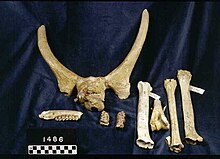 Horns and other fossils attributed to Dromomeryx
Horns and other fossils attributed to Dromomeryx- †Dromomeryx borealis
- †
- †
- †Dyticonastis – type locality for genus
- †Dyticonastis rensbergeri – type locality for species
E[]
- Echinophoria
- †
- †
- †
- †Ekgmowechashala
- †Emmenopterys
- †
- †EnaliarctosLife restoration of the Oligocene-Miocene Enaliarctos and the toothed whale Macrodelphinus (background)
- †Enaliarctos barnesi – type locality for species
- †Enaliarctos emlongi – type locality for species
- †Enaliarctos mitchelli
- †Enaliarctos tedfordi – type locality for species
- Engelhardtia
- †
- Enhydra
- †Enhydrocyon
- †
- †
- Ennucula
- †
- †Ensete
 Ensete
Ensete- † – type locality for species
- †
- †
- †
- †
- †
- †
- †Eopleurotoma
- † – or unidentified related form
- †
- †
- – report made of unidentified related form or using admittedly obsolete nomenclature
- †
- †Epicyon
 Mounted fossilized skeleton of the Miocene bone-crushing dog Epicyon
Mounted fossilized skeleton of the Miocene bone-crushing dog Epicyon- †Epicyon haydeni
- †
- †Epihippus
- †
- Epilucina
- †
- Epitonium
- †
- †
- †
- †
- †
- † – type locality for species
- †EporeodonFossilized skull of the Oligocene-Miocene oreodont mammal Eporeodon
- †
- †
- †Equisetum
- Equus
- †
- † – type locality for genus
- † – type locality for species
- †
- †Erismatura jamaicensis
- Erolia
- †
- Ervilia – tentative report
- †
- †
- † – type locality for genus
- † – type locality for species
- †Eucastor
- †
- †EucyonFossilized skeleton of the Miocene-Pliocene coyote-like canine Eucyon
- †Eucyon davisi
- †Euoplocyon
- †
- Euphagus
- †Euphagus cyanocephalus
- Eurytellina
- †
- Euspira
- †
- †
- †
- †Euspira pallida
- †Eutrephoceras
- †
- Exbucklandia
- †
- †Exilia
- † – type locality for species
- †
F[]
- Fagus
- †
- Falco
- † – type locality for species
- Felaniella
- †
-
- †
- †
- †
- Ficus
 A living Ficus, or fig tree
A living Ficus, or fig tree- †
- † – or unidentified comparable form
- Fimbria
- †
- †
- Flabellum
- † – type locality for species
- †
- †
- †
- †Floridaceras
- †
- †Florissantia
 Flower of the Eocene-Oligocene cocoa relative Florissantia
Flower of the Eocene-Oligocene cocoa relative Florissantia- †Florissantia ashwillii – type locality for species
- †Florissantia speirii
- †
- †
- †
- †
- †Fothergilla
- †
- †
- †
- †Fraxinus
- †
- Fulgoraria
- †
- Fulgurofusus
- † – type locality for species
- Fulica
- Fulica americana
 A living Fulica americana, or American coot
A living Fulica americana, or American coot - † – type locality for species
- † – type locality for species
- †
- † �� type locality for species
- Fusinus
- †
- †
G[]
- †
- † – type locality for species
- †Gaillardia
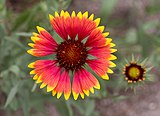 A living Gaillardia, or blanket flower
A living Gaillardia, or blanket flower- †
- Gari – tentative report
- † – or unidentified related form
- Gemmula
- †
- †
- †
- †Gentilicamelus
- † – type locality for species
- †
-
- †
- †
- †
- Glycymeris
- †
- †
- †
- †Goedertius – type locality for genus
- † – type locality for species
- †Gomphotherium
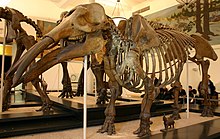 Mounted fossilized skeleton of the Miocene-Pleistocene elephant relative Gomphotherium
Mounted fossilized skeleton of the Miocene-Pleistocene elephant relative Gomphotherium- †
- †
- † – type locality for species
- Granula
- † – type locality for species
- Gyrineum – report made of unidentified related form or using admittedly obsolete nomenclature
- †
H[]
- †Hadrianus
- Halesia
- †
- Haliaeetus
- †Haliaeetus leucocephalus
- †Haplohippus
 Fossilized mandible of the Eocene horse Haplohippus
Fossilized mandible of the Eocene horse Haplohippus- †
- †
- †
- †Hemiauchenia – tentative report
- †Hemipsalodon
- †
- Hemithiris
- †
- †
- Heptranchias
- †Heptranchias howelli
- †Herpetotherium
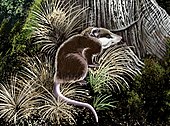 Life restoration of the Eocene-Miocene mammal Herpetotherium
Life restoration of the Eocene-Miocene mammal Herpetotherium- †
- † – or unidentified comparable form
- †
- † – type locality for species
- † – type locality for species
- †
- † – or unidentified comparable form
- † – tentative report
- Heteropora
- †
- †
- Hiatella
- Himantopus
- †Himantopus mexicanus
- †Hippotherium
- †Hoplophoneus
 Life restoration of the Eocene-Oligocene false saber-toothed cat Hoplophoneus. Robert Bruce Horsfall (1913).
Life restoration of the Eocene-Oligocene false saber-toothed cat Hoplophoneus. Robert Bruce Horsfall (1913).- †
- †
- †Hovenia
- †
- Hydrangea
- †
- †
- †
- †Hypertragulus
- †
- †Hypertragulus hesperius
- †
- †Hypohippus
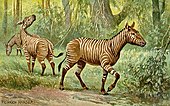
- †
- †Hypolagus
- †
- † – type locality for species
- †
- †
- † – tentative report
- †Hypsidoris
- † – type locality for species
- †Hypsiops
- †
- †Hyrachyus
- †
- †
- †
I[]
- †Indarctos
 Fossilized skull of the Miocene bear Indarctos
Fossilized skull of the Miocene bear Indarctos- † – type locality for species
- †
- †
- †Iodes
- †
- †
- †
- †
- †
- Isurus
J[]
- †
- †
- †
- †
- †
- †
- Juglans
 A living Juglans, or walnut tree
A living Juglans, or walnut tree- †
- †
K[]
- †Kalobatippus
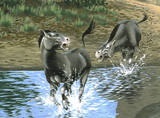 Restoration of the Oligocene-Miocene horse Kalobatippus
Restoration of the Oligocene-Miocene horse Kalobatippus - †Kardiasperma
- †Kardiasperma parvum
-
- †
- †
- † – type locality for species
- Kellia
- † – type locality for species
- † – type locality for species
- †Keteleeria
- †
- †
- † – type locality for species
- †Kolponomos
- †Kolponomos newportensis – type locality for species
L[]
- Lacuna
- †Lacuna vincta
 Illustration of shells in multiple views of Lacuna vincta, or northern lacuna sea snails
Illustration of shells in multiple views of Lacuna vincta, or northern lacuna sea snails
- Lamelliconcha
- †
- †
- †
- †
- Larus
- †Larus argentatus
- †Larus californicus
 A living Larus californicus, or California gull
A living Larus californicus, or California gull - † – type locality for species
- †Larus philadelphia
- † – type locality for species
- † – type locality for species
- †
- †
- †
- †
- †
- †
- †
- †
- Lepeta
- †
- †
- †
- †Leptocyon
 Illustration of a fossilized skull of the Oligocene-Miocene dog Leptocyon
Illustration of a fossilized skull of the Oligocene-Miocene dog Leptocyon- †
- †
- †Leptocyon vulpinus
- †
- † – type locality for species
- †
- Lepus
- †
- Leukoma
- †
- †
- †
- †
- †
- † – type locality for species
- Limnodromus
- †Limnodromus griseus – tentative report
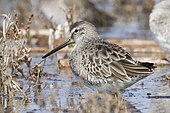 A living Limnodromus griseus, or short-billed dowitcher
A living Limnodromus griseus, or short-billed dowitcher
- †
- † – or unidentified comparable form
- Lindera
- †
- †
- †
- †
- †
- Liquidambar
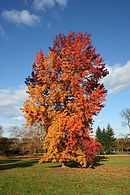 The autumn foliage of a living Liquidambar, or sweetgum tree
The autumn foliage of a living Liquidambar, or sweetgum tree - †
- †
- † – type locality for genus
- † – type locality for species
- †Lithocarpus
- †
- †
- †
- †
- †
- †
- †
- Littorina
- †
- †
- †Lobipes lobatus
- Lophodytes
- †Lophodytes cucullatusA living Lophodytes cucullatus, or hooded merganser
- †
- † – type locality for species
- †Lophortyx
- † – type locality for species
- Lucinoma
- †
- †
- †
- †
- †
- † – or unidentified comparable form
- Lynx
- †
- Lytechinus
 A living Lytechinus sea urchin
A living Lytechinus sea urchin- † – type locality for species
M[]
- †
- †
- †MachairodusFossilized cranium of the Miocene-Pleistocene saber-toothed cat Machairodus
- †Machilus
- †
- Macoma
- †
- †
- †
- †
- †
- †
- †Macoma nasuta
 Shell of Macoma nasuta, or the bent-nosed clam
Shell of Macoma nasuta, or the bent-nosed clam - †
- Macrocallista
- †
- †
- †
-
- †
- †
- †
- †
- †
- Magnolia
 Close-up view of a Magnolia flower
Close-up view of a Magnolia flower- †
- †
- †
- Mahonia
- †
- †Malus – or unidentified comparable form
- †Mammut
- †Mammut furlongi – type locality for species
- †Mammuthus
- †Mammuthus columbi – tentative report
 Life restoration of a herd of Mammuthus columbi, or Columbian mammoths. The extent of the fur depicted is hypothetical. Charles R. Knight (1909).
Life restoration of a herd of Mammuthus columbi, or Columbian mammoths. The extent of the fur depicted is hypothetical. Charles R. Knight (1909).
-
- †
- †
- Margarites
- †
- †
- †
- Martes
- † – type locality for species
- Martesia
- †
- Mastixia
- †
- †
- †
- †
- Megachasma
- †MegalonyxMounted fossilized skeleton of the Miocene-Pleistocene ground sloth Megalonyx
- †Megapaloelodus
- † – type locality for species
- †Megatylopus
-
- †
- Melanitta
- †Melanitta deglandi
- †Melanitta perspicillata
- †Meliosma
- †Meliosma beusekomii
- †
- †
- †
- †
- †
- †
- †Menispermum – or unidentified comparable form
- Mergus
- †Mergus merganser
- †Mergus serrator
- †Merychippus
 Life restoration of the Miocene three-toed horse Merychippus
Life restoration of the Miocene three-toed horse Merychippus- †
- †
- †Merychyus
- †Merychyus arenarum
- †
- †Merycochoerus
- †
- †
- †
- †Merycoides
- †
- †Merycoidodon
- †
- †Mesocyon
 Skull fossils of the Oligocene-Miocene dog Mesocyon
Skull fossils of the Oligocene-Miocene dog Mesocyon- †
- †
- †Mesohippus
- † – or unidentified comparable form
- †Metalopex
- †
- Metasequoia
- †Microphallus
- †
-
- †
- †
- †
- Microtus
- †Microtus montanus
- †Miohippus
 Fossilized skull of the Eocene-Oligocene three-toed horse Miohippus
Fossilized skull of the Eocene-Oligocene three-toed horse Miohippus- †
- †
- †
- †
- †
- †Miotapirus
- † – type locality for genus
- † – type locality for species
-
- †
- Modiolus
- †
- †Modiolus modiolus
- †
- †
- †
- †
- †
- †
- Molothrus
- †Molothrus ater – tentative report
- †Monosaulax
- † – type locality for species
- † – type locality for species
- †Moropus
 Life restoration of the Miocene chalicothere mammal Moropus threatening a pair of the bear-dog Daphoenodon. Jay Matternes (1964).
Life restoration of the Miocene chalicothere mammal Moropus threatening a pair of the bear-dog Daphoenodon. Jay Matternes (1964).- †
- Mulinia
- †
- Mustela
- †Mya
- †
- †Mya truncata
- †
- †
- Myotis – or unidentified comparable form
- †
- †
- † – type locality for genus[1]
- † – type locality for species[1]
- Mytilus
- †Mytilus californianus
- †Mytilus edulis
- †
- †
N[]
- †Nanotragulus – or unidentified comparable form
- Nassarius
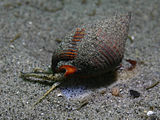 A living Nassarius, or nassa mud snail
A living Nassarius, or nassa mud snail- †
- †
- †
- †Nassarius perpinguis
- Natica
- †
- †
- †Nautilus
- † – type locality for species
- Nectandra
- †
- † – type locality for genus
- † – type locality for species
- Nemocardium
- †
- † – or unidentified comparable form
- †
- †Neohipparion
- † – or unidentified comparable form
- Neophrontops
 Mounted fossilized skeleton of the Miocene Neophrontops
Mounted fossilized skeleton of the Miocene Neophrontops- †
- Neotamias
- †
- †
- †
-
- †
- †Neurotrichus – tentative report
- †
- Neverita
- †
- †
- †
- †
- †Nexuotapirus
- †
- Nucella
- †
- †Nucella lamellosa
- †
- Nucula
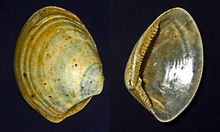 Interior of a fossilized shell of the Early Ordovician-modern marine bivalve Nucula
Interior of a fossilized shell of the Early Ordovician-modern marine bivalve Nucula- †
- Nuculana
- †
- †
- Numenius
- †Numenius americanus – tentative report
- †Nuphar
-
- †
- †
-
- †
- †
- † – tentative report
- †Nyssa
- †
- †Nyssa spatulata
O[]
- †
- Ochotona
 A living Ochotona, or pika
A living Ochotona, or pika- †Ochotona spanglei – type locality for species
- Ocotea
- †
- †
- † – type locality for species
- †
- †
- † – type locality for genus
- † – type locality for species
- Olar
- †
- †
- †
- †Oligobunis
- Olivella
- †Olivella biplicata
 Three living Olivella biplicata, or purple dwarf olive sea snail
Three living Olivella biplicata, or purple dwarf olive sea snail - †
- †Olivella pedroana
- †
- †
- Ondatra
- † – type locality for species
- Opalia
- †
- † – or unidentified comparable form
- †
- † – type locality for species
- †
- †Oreodontoides
- †
- †
- † – type locality for species
- † – type locality for genus
- † – type locality for species
- †Osbornodon
- †
- †Osmunda
 Living Osmunda ferns
Living Osmunda ferns- †
- Ostrea
- †Ostrea lurida – or unidentified comparable form
- Ostrya
- †
P[]
- †
- †
- †
- † – type locality for genus
- † – type locality for species
- †
- †
- †
- †
- †
- † – or unidentified comparable form
- †Palaeocastor
 Life restoration of the Oligocene-Miocene beaver Palaeocastor
Life restoration of the Oligocene-Miocene beaver Palaeocastor- †
- †Palaeolagus
- †
- †
- †
- †
- †
- †
- †Paleopanax
- †Paleopanax oregonensis
- † – tentative report
- †
- †
- †
- Paliurus
 Flowers and foliage of a living Paliurus
Flowers and foliage of a living Paliurus- †
- Pandora
- †
- †
- †
-
- †
- Panopea
- †Panopea abrupta
- †
- †
- Panthera
- †Panthera onca – or unidentified comparable form
 A living Panthera onca, or jaguar
A living Panthera onca, or jaguar
- †
- †
- †
- †Paracosoryx
- † – or unidentified comparable form
- †
- †
- †Paradaphoenus
- †
- †
- † – type locality for species
- †Paraenhydrocyon
- †Paraenhydrocyon josephi
- †
- †Parahippus
- †Parahippus leonensis – or unidentified related form
- †
- †Paramylodon
 Fossilized skeleton of the Pliocene-Pleistocene ground sloth Paramylodon
Fossilized skeleton of the Pliocene-Pleistocene ground sloth Paramylodon- †Paramylodon harlani
- †
- †
-
- †
- †
- †
- †
- †
- †Paratomarctus
- †
- †Paratylopus
 Life restoration the Eocene-Oligocene camel Paratylopus (upper right)
Life restoration the Eocene-Oligocene camel Paratylopus (upper right) - †Paronychomys
- † – type locality for species
- †Paroreodon
- †
- †
- †Parrotia
- †
- †Parthenocissus
- †
- †
-
- †
- Parvicardium
- †
- Passalus
- † – type locality for species
- †
- †
- Patinopecten
- †Patinopecten caurinus
- †
- †
- †
- †
- †Patriofelis
- †Patriofelis ferox
- †
- † – type locality for species
- † – type locality for species
- †
- Pekania
- † – type locality for species
- †Pelagornis
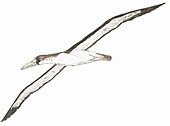 Life restoration of the Oligocene-Pleistocene false-toothed bird Pelagornis
Life restoration of the Oligocene-Pleistocene false-toothed bird Pelagornis - Pelecanus
- †Pelecanus erythrorhynchos
- †Pelecanus erythrorhynchus – tentative report
-
- †
- †
- †
- †Perchoerus
- †
- †
- †
- Periploma
- Perognathus
- † – type locality for species
- Peromyscus
 A living Peromyscus, or deer mouse
A living Peromyscus, or deer mouse- †
- †
- †Perse
- †
- †
- †
- Phalacrocorax
- †Phalacrocorax auritus – tentative report
- † – type locality for species
- †
- † – type locality for species
- Phalaropus
- †Phalaropus lobatus
- Phalium
- †
- †
- Phanerolepida
- †
- †Philotrox
- †Philotrox condoni
- †Phlaocyon
- †Phlaocyon latidens
- Phoca
- †Phoca vitulina – or unidentified comparable form
- † – type locality for genus
- † – type locality for species
- Phoenicopterus
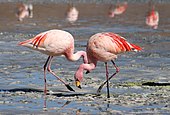 Two Phoenicopterus, or flamingos
Two Phoenicopterus, or flamingos- †Phoenicopterus copei – type locality for species
- †
- †
- †
- †Pinckneya
- †
- †
- †
- †
- † – type locality for species
- Pinus
 A living Pinus, or pine tree
A living Pinus, or pine tree- †
- †
- †
- †
- Pitar
- †
- †
- †
- †
- †Plagiolophus
- †
- Platanus
- †
- †
- ���
- †
- †
- †Platygonus
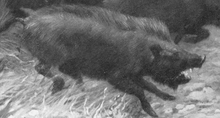 Restoration of a herd of alarmed Miocene-Pleistocene peccaries of the genus Platygonus. Charles R. Knight (1922).
Restoration of a herd of alarmed Miocene-Pleistocene peccaries of the genus Platygonus. Charles R. Knight (1922).- †
- †
- † – or unidentified comparable form
- †Pleiolama
- † – or unidentified comparable form
- †Plesiocolopirus
- †
- †Plesiogulo
- †
- †
- † – or unidentified comparable form
- †
- †
- †
- †
- †
- †
- †
- †Pliocyon – or unidentified comparable form
- †
- †Pliohippus
 Fossilized skull of the Miocene horse Pliohippus
Fossilized skull of the Miocene horse Pliohippus- †
- †Plionarctos
- †
- †
- †
- †
- †
- †
- †
- †
- Podiceps
- †Podiceps auritus – tentative report
- Podilymbus
- †Podilymbus podiceps
- Pododesmus
- †Pogonodon
 Life restoration of the Oligocene false saber-toothed cat Pogonodon in a tree
Life restoration of the Oligocene false saber-toothed cat Pogonodon in a tree- †
- † – type locality for species
- Polinices
- †
- †
- †
- †
- †
- †
- †
- †
- †
- †
- †
- †
- †Polypodium – or unidentified comparable form
 Fronds of living Polypodium ferns
Fronds of living Polypodium ferns - †Pontolis – type locality for genus
- †Pontolis magnus – type locality for species
- †Potamogeton
- †
- †
- †
- †
- †
- †
- † – or unidentified comparable form
- †
- †
- †
- †
- †Pristichampsus
- † – report made of unidentified related form or using admittedly obsolete nomenclature
- †Procamelus
- †Procamelus grandis – or unidentified comparable form
- †
- †
- – type locality for genus
- † – type locality for species
- †Promartes – or unidentified comparable form
- †Promerycochoerus
- †
- †
- †Proneotherium – type locality for genus
- † – type locality for species
- †
- Propeamussium
- † – or unidentified comparable form
- †
- † – type locality for species
- †
- † – tentative report
- † – type locality for genus
- † – type locality for species
- †Protitanops
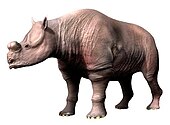 Life restoration of the Eocene brontothere mammal Protitanops
Life restoration of the Eocene brontothere mammal Protitanops- †
- †Protolabis – or unidentified comparable form
- † – type locality for genus[2]
- †
- †
- Protothaca
- †
- †
- †
- Prunus
- †
- †
-
- †
- †Psephophorus – tentative report
- † – type locality for species
- †Pseudaelurus
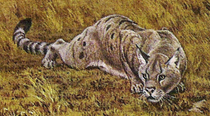 Restoration of the Miocene cat Pseudaelurus
Restoration of the Miocene cat Pseudaelurus - †
- †
- †
- †
- †
- †
- †
- †Pseudotsuga
- †
- Pteris
- †
- Pterocarya
- †
- †
- †Pteronarctos – type locality for genus
- † – type locality for species
- † – type locality for species
- †Pteronepelys
- †Pteronepelys wehrii
- †
- †
- Puncturella
- – tentative report
- Purpura
- †
- †
- Pyramidella – tentative report
- Pyrenacantha
- †
- †
- †
- †Pyrus
 Fruit of a living Pyrus, or pear tree
Fruit of a living Pyrus, or pear tree- †
Q[]
- Quercus
 A living Quercus, or oak tree
A living Quercus, or oak tree- †
- †
- †
- Querquedula
- † – type locality for species
- †
- †
R[]
- Raja
- Rallus
- †Rallus limicola
-
- †
- Recurvirostra
- †Recurvirostra americana
 A living Recurvirostra americana, or American avocet
A living Recurvirostra americana, or American avocet
- Retusa
- †
- †
- †
- Rhabdus
- †
- †Rhizocyon
- †
- Rhus
- †
- †Rhus rooseae
- †
- †Ribes
- Rimella
- Rosa
- †
- Rubus
 A living member of Rubus, the genus including blackberries (pictured) and raspberries
A living member of Rubus, the genus including blackberries (pictured) and raspberries- †
- †
- † – type locality for genus
- † – type locality for species
- †
- †
S[]
- Sabal
 Living Sabal, or palmettos
Living Sabal, or palmettos- †
- †
- †Sabia
- †
-
- †
- †
-
- ��� – type locality for species
- †
- †
- †
- Sanguinolaria
- †
- †
- †
- Sargentodoxa[3]
- †* [3] – type locality for species
- Sassia
- †
-
- †
- Saxidomus
- †Saxidomus gigantea
 Shell of a living Saxidomus gigantea, or butter clam
Shell of a living Saxidomus gigantea, or butter clam - †
- †
- †
- †
- †
- †
- †
-
- †
- † – or unidentified related form
- †
- †
- †
- †
- Scapanus
- †Scapanus latimanus
- †
- † – or unidentified comparable form
- Scaphander
 Shells in multiple views of a Scaphander canoe bubble sea snail
Shells in multiple views of a Scaphander canoe bubble sea snail- †
- † – type locality for species
- †
- †
- †
- †Schisandra
- †
- Schizaster
- †
- †
- †
- Sciurus
 A living Sciurus squirrel
A living Sciurus squirrel- †
- †
- †
- † – type locality for species
- †Scutella
- †
- – tentative report
- †
- Semele
- †
- Sequoia
- †
- † – type locality for species
- †
- † – or unidentified comparable form
- Sideroxylon
- † – type locality for species
- Siliqua
- †Siliqua patula
- †Simocetus – type locality for genus
- † – type locality for species
- †Simocyon
 Reconstruction of a fossilized skull and restorative portrait of the Miocene-Pliocene red panda relative Simocyon
Reconstruction of a fossilized skull and restorative portrait of the Miocene-Pliocene red panda relative Simocyon- †
-
- †
- Sinum
- †
- †
- Solariella
- † – type locality for species
- †
- Solemya
- †
- Solen
- †
- †
-
- †
- †
- †
- †SomatochloraA living Somatochlora dragonfly
- † – type locality for species
- Spermophilus
- †
- †
- †
- †
- †
- †
- †
- †
- †
- †
- †
- †
- Spirotropis
- †
- †
- †
- Spisula
- †
- †
- Spizaetus
- †
- †SteneofiberFossilized partial skulls of the rodent Oligocene-Miocene Steneofiber
- †
-
- †
- †
- † – type locality for species
- Stercorarius
- † – type locality for species
- Sterna
- †Sterna elegans – tentative report
- †Sterna forsteri
- † – tentative report
- SthenictisFossilized skeleton of the Miocene weasel Sthenictis
- † – type locality for species
- † – tentative report
- †
- †
- †
- †
- † – type locality for species
- †
- †
- Strongylocentrotus
- Sturnella
- †Suavodrillia
- †
- †Subhyracodon
 Life restoration of the Eocene-Oligocene cow-sized rhinoceros Subhyracodon. Charles R. Knight (1890s).
Life restoration of the Eocene-Oligocene cow-sized rhinoceros Subhyracodon. Charles R. Knight (1890s). -
- †
- †
- Sveltella
- †
- † – type locality for species
- Symplocos
- †
T[]
- †
- †
- TapirusA living Tapirus, or tapir
- †Tapirus californicus – or unidentified comparable form
- Tapiscia
- †
- Taranis
- †
- †
- † – or unidentified comparable form
- Taxidea
- †Taxus
- †Taxus masonii
- Tegula
- †
- †
- †
- †Teleoceras
 Restoration of the Miocene-Pliocene rhinoceros Teleoceras
Restoration of the Miocene-Pliocene rhinoceros Teleoceras- †
- †
- †
- †
- † – type locality for species
- Tellina
 Shell of a Tellina, or tellin
Shell of a Tellina, or tellin- †
- †
- †
- †
- † – or unidentified related form
- †
- †
- †
- †Temnocyon
- †
- † – type locality for species
- † – or unidentified comparable form
- †
- †
- †Tephrocyon
- †
- Terebratalia
- †
- Terebratulina
- †
- Terminalia
- †
- †TetraclinisFoliage and cones of a living Tetraclinis, or arar tree
- †
- Thais
- †
- † – or unidentified related form
- †
- †
- Thesbia – report made of unidentified related form or using admittedly obsolete nomenclature
- †: synonym of † (F. Anderson & B. Martin, 1914)
- †
- †
- Thomomys
- †Thomomys townsendii
- Thracia
- †
- † – type locality for species
- †
- †Ticholeptus
 Fossilized skull of the Miocene oreodont mammal Ticholeptus
Fossilized skull of the Miocene oreodont mammal Ticholeptus- †
- †
- †
- †
- †
- Tilia
- †
- †
- †
- †
- †
- †
- †
- †
- Tinospora
- †
- †
- †Torreya
 Foliage of a living Torreya, or nutmeg yew
Foliage of a living Torreya, or nutmeg yew- †Torreya clarnensis
- †
- Totanus
- †
- †Toxicodendron
- †
- Trema
- †
- Tresus
- †
- Trichotropis
 Shell of a Trichotropis cap sea snail
Shell of a Trichotropis cap sea snail- †
- †
- †
- †
- †
- †
- †
- †
- †
- †
- † – type locality for genus
- † – type locality for species
- †
- †
- †
- †
- Trochita
- Trophon
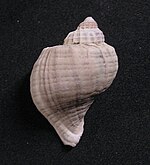 Shell of a Trophon murex snail
Shell of a Trophon murex snail- †
- †
- † – type locality for species
- †
- †
- † – type locality for genus[2]
- †[2]
- †Tsuga
- †
- Turricula
- †
- †
- †
- †
- †
- † – or unidentified comparable form
- Turris
- †
- †
- †
- †
- Turritella
 Fossilized shells of the Late Jurassic-modern tower snail Turritella
Fossilized shells of the Late Jurassic-modern tower snail Turritella- †
- †
- † – type locality for species
- †
- †
- †
- †Tylocephalonyx
- Tympanuchus
- †Tympanuchus pallidicinctus
- †
- †
U[]
- Ulmus
 A living Ulmus, or elm
A living Ulmus, or elm- †
- †
- †
- †
- †Unknown
- †
- †
- †Ursavus
- † – or unidentified comparable form
V[]
- Venericardia
- † – or unidentified comparable form
- †
- † – or unidentified comparable form
- †
- †
- † – or unidentified comparable form
- †Viburnum
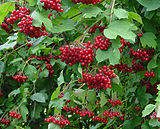 Leaves and fruit of a living Viburnum.
Leaves and fruit of a living Viburnum.- †
- Vitis
 Leaves and fruit of a living Vitis, or grapevine
Leaves and fruit of a living Vitis, or grapevine- †
- †
- Vulpes
- †
W[]
- †
- †
X[]
- Xema
 A living Xema sabini, or Sabine's gull
A living Xema sabini, or Sabine's gull- †
- †
- †
- † – type locality for genus
- † – type locality for species
Y[]
- † – type locality for genus[4]
- † – type locality for species[4]
- Yoldia
- †Yoldia cooperii – or unidentified comparable form
- †
- †
- †
- †
Z[]
- Zalophus
- †Zalophus californianus
 A living Zalophus californianus, or California sea lion
A living Zalophus californianus, or California sea lion
- †
- † – type locality for species
- Zelkova
- †
- †
- †
References[]
- ^ a b c d Gerald R. Smith; Jay Van Tassell (2019). "Fishes of the Mio-Pliocene Western Snake River Plain and vicinity. V. Keating, Always Welcome Inn, and Imbler Fish paleofaunas, NE Oregon: Tests of Miocene-Pliocene drainage connections". Miscellaneous Publications. Museum of Zoology, University of Michigan. 204 (5): 1–33. hdl:2027.42/150494.
- ^ a b c Robert A. Martin; Richard J. Zakrzewski (2019). "On the ancestry of woodrats". Journal of Mammalogy. 100 (5): 1564–1582. doi:10.1093/jmammal/gyz105.
- ^ a b Manchester, S. R. (1999). "Biogeographical relationships of North American tertiary floras". Annals of the Missouri Botanical Garden. 86: 472–522. doi:10.2307/2666183. JSTOR 2666183.
- ^ a b Olivier Lambert; Stephen J. Godfrey; Erich M. G. Fitzgerald (2019). "Yaquinacetus meadi, a new latest Oligocene–early Miocene dolphin (Cetacea, Odontoceti, Squaloziphiidae, fam. nov.) from the Nye Mudstone (Oregon, U.S.A.)". Journal of Vertebrate Paleontology. 38 (6): e1559174. doi:10.1080/02724634.2018.1559174. S2CID 108903672.
- Various Contributors to the Paleobiology Database. "Fossilworks: Gateway to the Paleobiology Database". Retrieved 7 August 2017.
{{cite web}}:|author=has generic name (help)
Categories:
- Paleontology in Oregon
- Lists of the Cenozoic life of the United States by state































































































